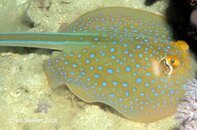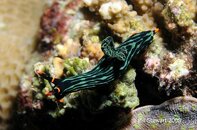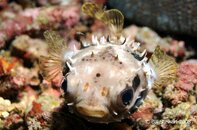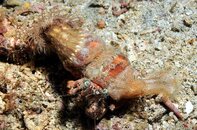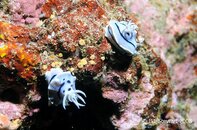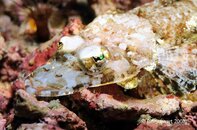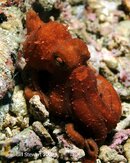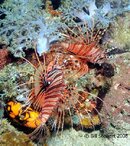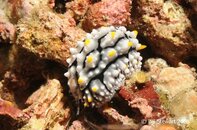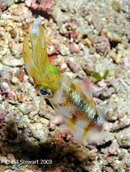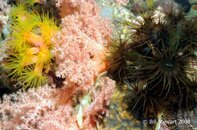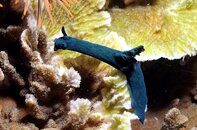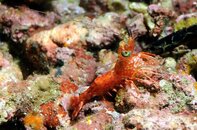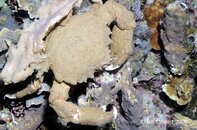I would like to say thank you to all my friends from online who have always so freely given of their time in sharing their knowledge and experience. In particular I want to thank the members of Philippine Paradise Divers at www.scubaboard.com It was great to finally get to meet so many of you in person!
Just got home to Japan yesterday afternoon from a two week trip to the Philippines. This trip was spent diving Anilao and Puerto Galera. In all I did 36 dives starting with a night dive at Koala Reef on the 1st of June right after I arrived in Anilao and ending with a morning dive on Dungeon Wall on June 11th in Puerto Galera.
I gave my new Nikon D300 a workout coming back with over 2300 photos recorded in Large (4288 x 2848) JPEG Fine. I worked with two 4.0 GB SanDisk Ultra II CompactFlash cards. Each card would hold over 300 photos recorded at this setting and would usually get me through at least 2-3 dives.
I’m using an Ikelite Housing and an Ikelite DS125 substrobe. I can’t even begin to describe how nice it is to have TTL flash again! Now I can go back to focusing on my photos and not have to split my attention as I make estimates on manual exposure!
I took my Canon A630 with me along with the housing as a backup, but used it mainly for above water shots as I didn’t like removing my Nikon from the housing while on the boat if I could avoid it. Many of the above water shots, especially if they were taken from the boat were taken with this camera.
Just before the trip I opted to purchase a PhotoBank from SmartDisk http://www.smartdisk.com/staticpages/PhotoBank2.asp rather than carry a laptop. With enough space for up to 40 gigs of photos, this looked like it would be a good, lightweight and inexpensive alternative to the pain of carrying a laptop or the expense of purchasing additional compact flash cards.
This ended up working pretty well, the only problem being that without a reader, I didn’t get to view my photos other than reviewing them on the camera screen until after I got back. Last night after downloading all my photos to my computer here at home, I discovered that I had somehow gotten the two cards mixed up one morning and had inadvertently cleaned one card without downloading the photos first.
This was particularly painful as that particular series of dives (my first in Puerto Galera this trip) included a couple of images I would have paid money to enter into a photo contest! They included perhaps the best moray shot I’ve ever taken and a total of five frogfish (three different types) one of which I had a nice shot with my guide checking it out. I know, I know…. you’ll just have to take my word for it I’ve decided this morning that I’m not going to slit my wrists over it, but I’m still definitely a little depressed about it
I’ve decided this morning that I’m not going to slit my wrists over it, but I’m still definitely a little depressed about it 
I’ve said before that I would talk a little about the process I go through when I plan my trips.
First comes the toughest part…. Deciding where to go! My favorite destination being the Philippines which with over 7100 islands, having the second largest reef system in Southeast Asia, and being part of the center of biodiversity for the entire world, makes for some tough choices!
Anilao has always been on my list of dive destination in the Philippines since I first started seriously researching the diving there a year ago. Although, I had dived in Puerto Galera last year when I returned to scuba diving after a long layoff, I had always wanted to go back so that I could do a more in-depth exploration of the area. They are close enough together to do both in one trip with a minimum of time lost to travel.
These two areas lie on different sides of the Verde Passage which was described in a joint study between the American Smithsonian Institute and the World Conservation Union as being the “center of the center for the worlds marine biodiversity”. What this means in practical terms, is that you will find more marine species in a smaller area than you will in any other marine environment on the planet!
Of course this doesn’t mean that there aren’t plenty of other places and each destination always has something unique about it. Places, like Yap, Chuuk, Bikini Atoll, Hawaii, Galapagos, Papua, New Guinea, Fiji, Great Barrier Reef and the Coral Sea from Australia, Thailand, Wakatobi, Sipadan, Bali, Red Sea, South Africa….. (it’s a very long list, I know and it‘s only a partial list at that ) all have things that make them unique and are all places that I want to dive some day. Both Malapascua Island and Moalboal, places I've dived previously in the Philippines have things to offer that Anilao and Puerto Galera do not, and vice-versa.
) all have things that make them unique and are all places that I want to dive some day. Both Malapascua Island and Moalboal, places I've dived previously in the Philippines have things to offer that Anilao and Puerto Galera do not, and vice-versa.
That is part of the beauty of travel and of diving. For me personally, it is the feeling of discovery that I experience. The opportunity to see the beauty of this planet, the chance to meet new people, try new things… I’m sure many of you who are reading this, know exactly what I mean.
For the moment though the Philippines remain my number one choice for a variety of reason including the ones I’ve stated above and my current proximity to the Philippines. Having said that though, even if I lived in the US now, I would still consider the Philippines as one of my top choices for a diving vacation.
I do the majority of my research online. I’ll look at the area, what types of dives are there, what I can expect to see. I utilize the discussion forums online as there is nothing like getting the experience of someone who has actually been there or who already lives in the area that you are considering traveling too. I also look at costs… what I can expect to pay for diving, what I can expect to pay for a place to stay, etc… so that I can start working up a budget for the trip.
Once I have a rough idea of where I want to go, I start pricing plane fare. I normally go to Expedia www.expedia.com and get their price first. Then I go to at least two travel agents and get their best price for the dates I want to travel and the airline. Then I pick the best price.
I have frequent flyer with Philippine Airlines. I purchased their Sports Plus card which gives me an extra baggage allowance. With my dive gear and camera equipment, I need it! An important thing for people coming from the US to remember is that standard baggage allowance in this part of the world is only 20 kilos (54 lbs) and 10 kilos (22 lbs) for carryon. You can rent gear fairly inexpensively in a lot of places though, so that is also an option. It’s all about where you want to spend your money and that is very subjective.
My last two trips to the Philippines, I’ve made firm plans for the beginning of the trip and left the end of the trip more or less open. This gives me some flexibility. My last trip, I extended my stay in Malapascua and ended up switching my plans to Moalboal for the second part.
This trip I wanted to have flexibility mainly because of concerns about weather. If you come during Typhoon season, you have to be prepared to make adjustments (same as travel in the Caribbean during Hurricane season) . After hearing that weather had been known to bring ferry service to a halt for up to 3 days, I didn’t want to get stuck over in Puerto Galera.
This isn’t to say that one shouldn’t come during the rainy season. Plenty of good diving still going on, and as I like to say, “it doesn’t rain underwater” During the off-season is also when you can find some of the best deals on diving and accommodations and it is definitely much less crowded. As it turned out, I had beautiful weather the entire two weeks that I was there. I seem to be lucky that way
During the off-season is also when you can find some of the best deals on diving and accommodations and it is definitely much less crowded. As it turned out, I had beautiful weather the entire two weeks that I was there. I seem to be lucky that way 
(to be continued)
Just got home to Japan yesterday afternoon from a two week trip to the Philippines. This trip was spent diving Anilao and Puerto Galera. In all I did 36 dives starting with a night dive at Koala Reef on the 1st of June right after I arrived in Anilao and ending with a morning dive on Dungeon Wall on June 11th in Puerto Galera.
I gave my new Nikon D300 a workout coming back with over 2300 photos recorded in Large (4288 x 2848) JPEG Fine. I worked with two 4.0 GB SanDisk Ultra II CompactFlash cards. Each card would hold over 300 photos recorded at this setting and would usually get me through at least 2-3 dives.
I’m using an Ikelite Housing and an Ikelite DS125 substrobe. I can’t even begin to describe how nice it is to have TTL flash again! Now I can go back to focusing on my photos and not have to split my attention as I make estimates on manual exposure!
I took my Canon A630 with me along with the housing as a backup, but used it mainly for above water shots as I didn’t like removing my Nikon from the housing while on the boat if I could avoid it. Many of the above water shots, especially if they were taken from the boat were taken with this camera.
Just before the trip I opted to purchase a PhotoBank from SmartDisk http://www.smartdisk.com/staticpages/PhotoBank2.asp rather than carry a laptop. With enough space for up to 40 gigs of photos, this looked like it would be a good, lightweight and inexpensive alternative to the pain of carrying a laptop or the expense of purchasing additional compact flash cards.
This ended up working pretty well, the only problem being that without a reader, I didn’t get to view my photos other than reviewing them on the camera screen until after I got back. Last night after downloading all my photos to my computer here at home, I discovered that I had somehow gotten the two cards mixed up one morning and had inadvertently cleaned one card without downloading the photos first.
This was particularly painful as that particular series of dives (my first in Puerto Galera this trip) included a couple of images I would have paid money to enter into a photo contest! They included perhaps the best moray shot I’ve ever taken and a total of five frogfish (three different types) one of which I had a nice shot with my guide checking it out. I know, I know…. you’ll just have to take my word for it
I’ve said before that I would talk a little about the process I go through when I plan my trips.
First comes the toughest part…. Deciding where to go! My favorite destination being the Philippines which with over 7100 islands, having the second largest reef system in Southeast Asia, and being part of the center of biodiversity for the entire world, makes for some tough choices!
Anilao has always been on my list of dive destination in the Philippines since I first started seriously researching the diving there a year ago. Although, I had dived in Puerto Galera last year when I returned to scuba diving after a long layoff, I had always wanted to go back so that I could do a more in-depth exploration of the area. They are close enough together to do both in one trip with a minimum of time lost to travel.
These two areas lie on different sides of the Verde Passage which was described in a joint study between the American Smithsonian Institute and the World Conservation Union as being the “center of the center for the worlds marine biodiversity”. What this means in practical terms, is that you will find more marine species in a smaller area than you will in any other marine environment on the planet!
Of course this doesn’t mean that there aren’t plenty of other places and each destination always has something unique about it. Places, like Yap, Chuuk, Bikini Atoll, Hawaii, Galapagos, Papua, New Guinea, Fiji, Great Barrier Reef and the Coral Sea from Australia, Thailand, Wakatobi, Sipadan, Bali, Red Sea, South Africa….. (it’s a very long list, I know and it‘s only a partial list at that
That is part of the beauty of travel and of diving. For me personally, it is the feeling of discovery that I experience. The opportunity to see the beauty of this planet, the chance to meet new people, try new things… I’m sure many of you who are reading this, know exactly what I mean.
For the moment though the Philippines remain my number one choice for a variety of reason including the ones I’ve stated above and my current proximity to the Philippines. Having said that though, even if I lived in the US now, I would still consider the Philippines as one of my top choices for a diving vacation.
I do the majority of my research online. I’ll look at the area, what types of dives are there, what I can expect to see. I utilize the discussion forums online as there is nothing like getting the experience of someone who has actually been there or who already lives in the area that you are considering traveling too. I also look at costs… what I can expect to pay for diving, what I can expect to pay for a place to stay, etc… so that I can start working up a budget for the trip.
Once I have a rough idea of where I want to go, I start pricing plane fare. I normally go to Expedia www.expedia.com and get their price first. Then I go to at least two travel agents and get their best price for the dates I want to travel and the airline. Then I pick the best price.
I have frequent flyer with Philippine Airlines. I purchased their Sports Plus card which gives me an extra baggage allowance. With my dive gear and camera equipment, I need it! An important thing for people coming from the US to remember is that standard baggage allowance in this part of the world is only 20 kilos (54 lbs) and 10 kilos (22 lbs) for carryon. You can rent gear fairly inexpensively in a lot of places though, so that is also an option. It’s all about where you want to spend your money and that is very subjective.
My last two trips to the Philippines, I’ve made firm plans for the beginning of the trip and left the end of the trip more or less open. This gives me some flexibility. My last trip, I extended my stay in Malapascua and ended up switching my plans to Moalboal for the second part.
This trip I wanted to have flexibility mainly because of concerns about weather. If you come during Typhoon season, you have to be prepared to make adjustments (same as travel in the Caribbean during Hurricane season) . After hearing that weather had been known to bring ferry service to a halt for up to 3 days, I didn’t want to get stuck over in Puerto Galera.
This isn’t to say that one shouldn’t come during the rainy season. Plenty of good diving still going on, and as I like to say, “it doesn’t rain underwater”
(to be continued)
Last edited:




